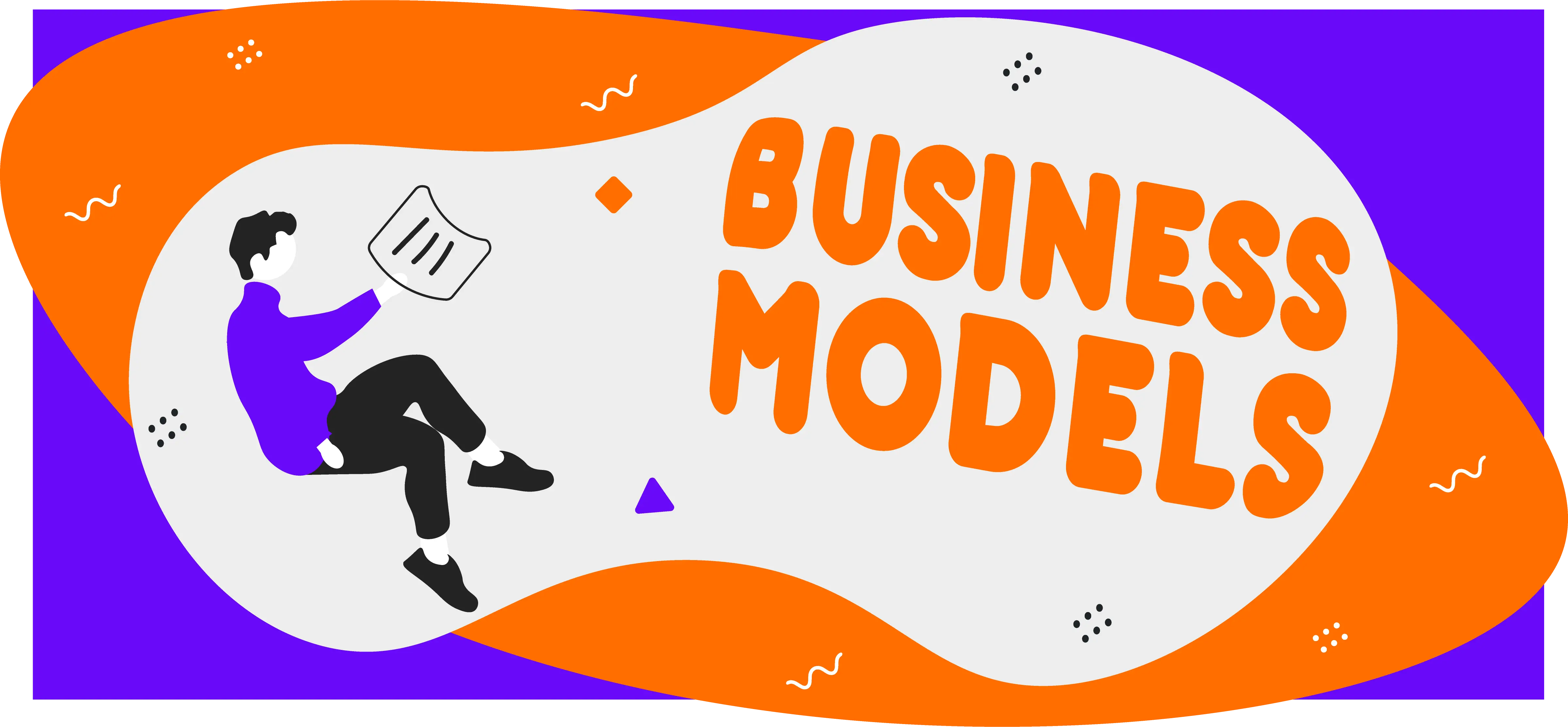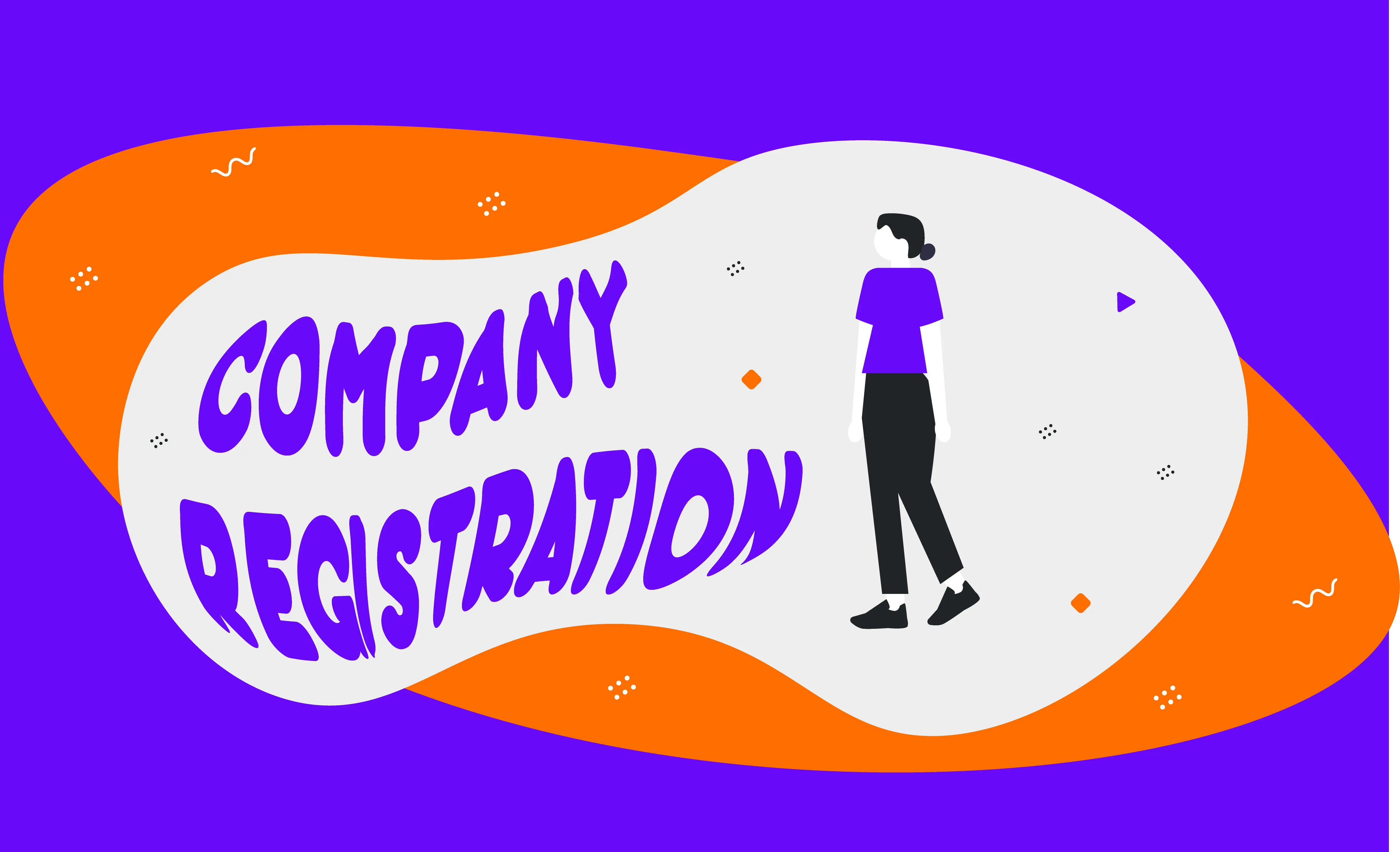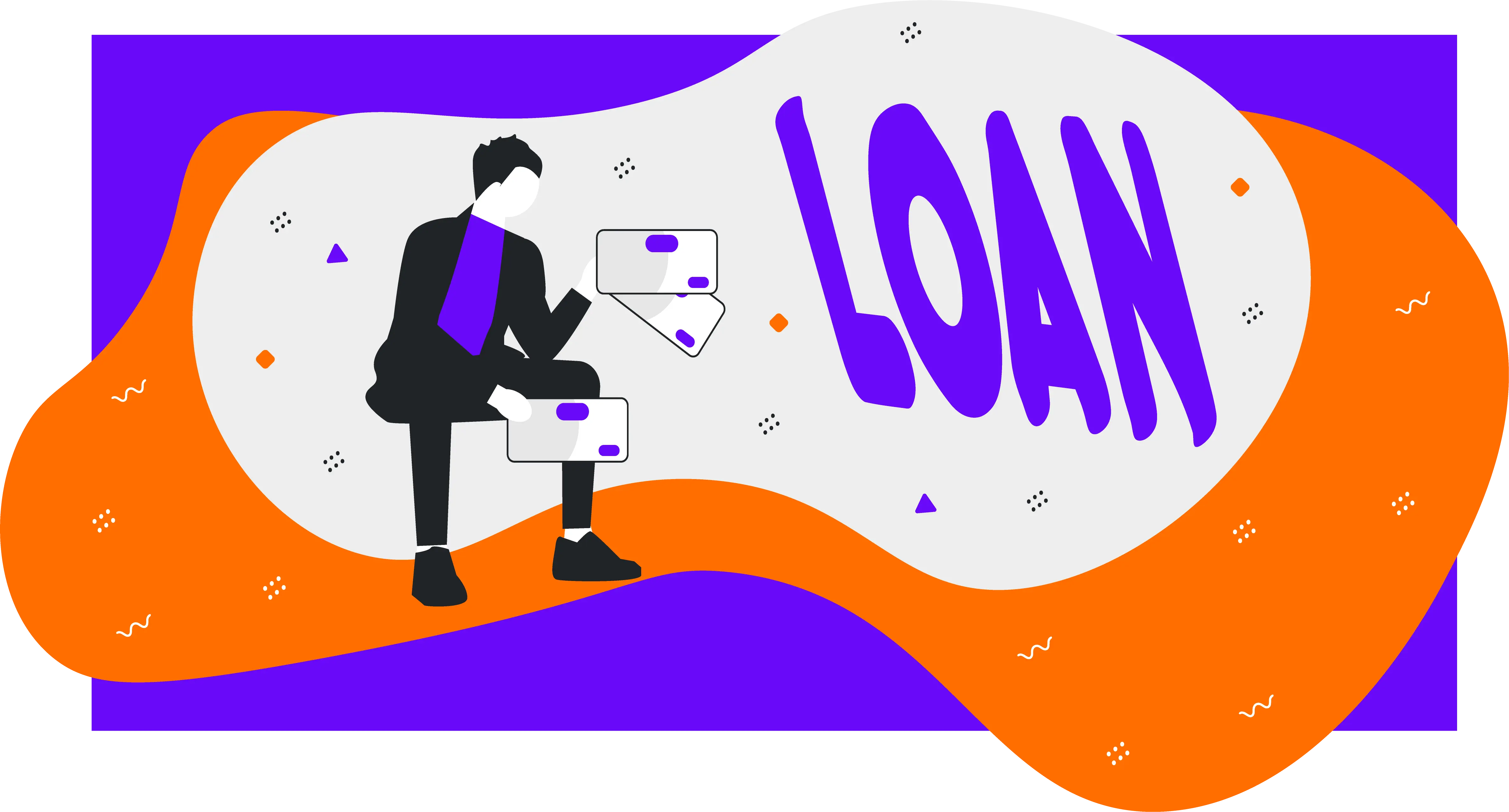How to write and create a business model
Business model analysis
In this blog post, we explain how to write and create a business model, what a business model canvas is, and provide examples of them.

Table of contents
- Introduction
- Why should you create a business model?
- What is the difference between a business model vs a business plan?
- What is business model innovation?
- How to write and create a business model
- Business model canvas explained
- What is a sustainable business model canvas?
- Business model canvas template
- Examples of a business model canvas
- Conclusion
When creating a company, startup owners should have an innovative business model that outlines the structure of their business, its position in the market and how they plan to attract customers and make money. Business model analysis can either be in the form of a written document or a canvas. Either format will showcase the main points regarding your company and what it does.
Why should you create a business model?
Not only is a business model beneficial to potential investors, but it can also help the company and its staff. The model allows a business to understand its idea better, as well as its target demographic and revenue forecasting. With a business model, a company owner can create new strategies and hold discussions with fellow employees. Moreover, it is a simplified way of describing the structure of a business.
What is the difference between a business model vs a business plan?
People often get the terms "business model" and "business plan" confused with one another when there is a distinction between the two. Business models describe how a business aims to deliver products or services to customers, focusing on specific sales funnels and marketing strategies. In contrast, a business plan is a far more detailed document explaining every facet of the business. They often include financial information alongside mission statements. While business models are used for reference among staff within a company, this is not the case for a business plan, which is primarily aimed at potential investors and stakeholders. Investors are still able to look at business models as well, however.
What is business model innovation?
Business model innovation is the concept of enchanting advantage and value creation by changing a company’s value proposition and operating model. Regarding the value proposition, these changes usually focus on the target market, product or service offering and revenue model. For the operational model level, the main aim is how to drive profitability, competitive advantage, and value creation. It’s important to consider the following when deciding how to deliver the value proposition:
- Where to play along the value chain
- What cost model is required for feasible returns
- What organisational structures and capabilities are vital for success
There are four approaches to business model innovation, which can allow all business owners to make effective choices in helping their company to grow:
- The reinventor approach usually arises during industry challenges, when a business model deteriorates slowly, and its growth prospects are uncertain. The business will need to work at reinventing its value proposition to ensure further success
- The adapter approach: involves adapters looking at similar businesses or markets and building an innovation engine to find a “new core” space with the right business model
- The maverick approach: these are either startups or established companies that employ their core advantage to revolutionise their industry and set new standards. They will need to be able to continuously evolve the competitive edge of the business to further their growth
- The adventurer approach: expands a business’ operation by exploring or venturing into new territories. The company will need to have an understanding of its competitive advantage so it can succeed in new markets
To make the most of business model innovation, your company will need to be open to adapting to address new challenges and opportunities, all while creating value.
How to create a business model
When creating a business model, whether written or in canvas form, it will need to include the nine standard elements to help illustrate and summarise what a company does. The nine points of a business model are:
Key partners: the partnerships your business has established and relies upon for success. Include the value and any sources that your business benefits from as a result of these partnerships
- Key activities: the main activities or tasks that allow your business to provide services and deliver on your value proposition
- Key resources: the assets your business takes advantage of to operate and provide services
- Value propositions: the value propositions are arguably the most important part of the business model canvas. It helps determine the main aim of your company and what you are trying to give to customers
- Customer relationships: the primary relationship a business has with its customers. It would help if you described how you interact with them and how these interactions may differ depending on the different types of customers
- Channels: in your business model canvas, you should use the channel section to discuss the methods used that enable you to reach your customers and deliver the value proposition to them
- Customer segments: outline your ideal customer personas that your value proposition is intended to benefit from. Then talk about the key differences between these and the potential steps in a customer's journey
- Cost structure: share information on the money spent on operating your business and detail the relationship between these costs and other business functions
- Revenue streams: finally, mention how your business can generate revenue through your value proposition
Alongside the above points, the main goal you want to achieve is creating value through business model innovation - essentially introducing a unique value proposition that will enable your business to stand out from competitors and take advantage of changes in the market and customer demands.
Business model canvas explained
A business model canvas (BMC) is a strategic management tool that helps define and communicate a visual representation of a business idea or concept. It is a one-page document, created through the Lean Canvas business model approach, that gives a visual example of how a startup operates and hopes to deliver on its value proposition in a condensed form.
The business model canvas template was first introduced by Alexander Osterwalder in his 2004 thesis, "The Business Model Ontology - A Proposition in a Design Science Approach". Since then, the canvas has become a popular way for companies to develop innovation through business models. As a result, the canvas approach is often taught at business schools as well.
What is a sustainable business model canvas?
A sustainable business model canvas supports the development of an idea into a business model, using a holistic approach regarding relationships both within and outside of a business. A sustainable business model canvas focuses on economic criteria alongside a business's ecological and social consequences. Its main aim is to eliminate a negative impact on society while maximising a positive approach to the way business is conducted. In other words, the aim is to integrate sustainability into the core business. It’s important to note that the general concept of the business model canvas is applied throughout.
Business model canvas template
Are you looking to create a business model canvas of your own but don't know how to structure or design it without a guide? At biznesfunding, we provide a free canvas business model template for all startup owners. The template is a sample of how you would expect a business model to look, and with its blank space, you can also design and tailor it to your business. Our business model canvas template is available in PowerPoint (ppt) and Excel formats. So what are you waiting for? Click the button below to get your template now.
Free Business Model Canva Template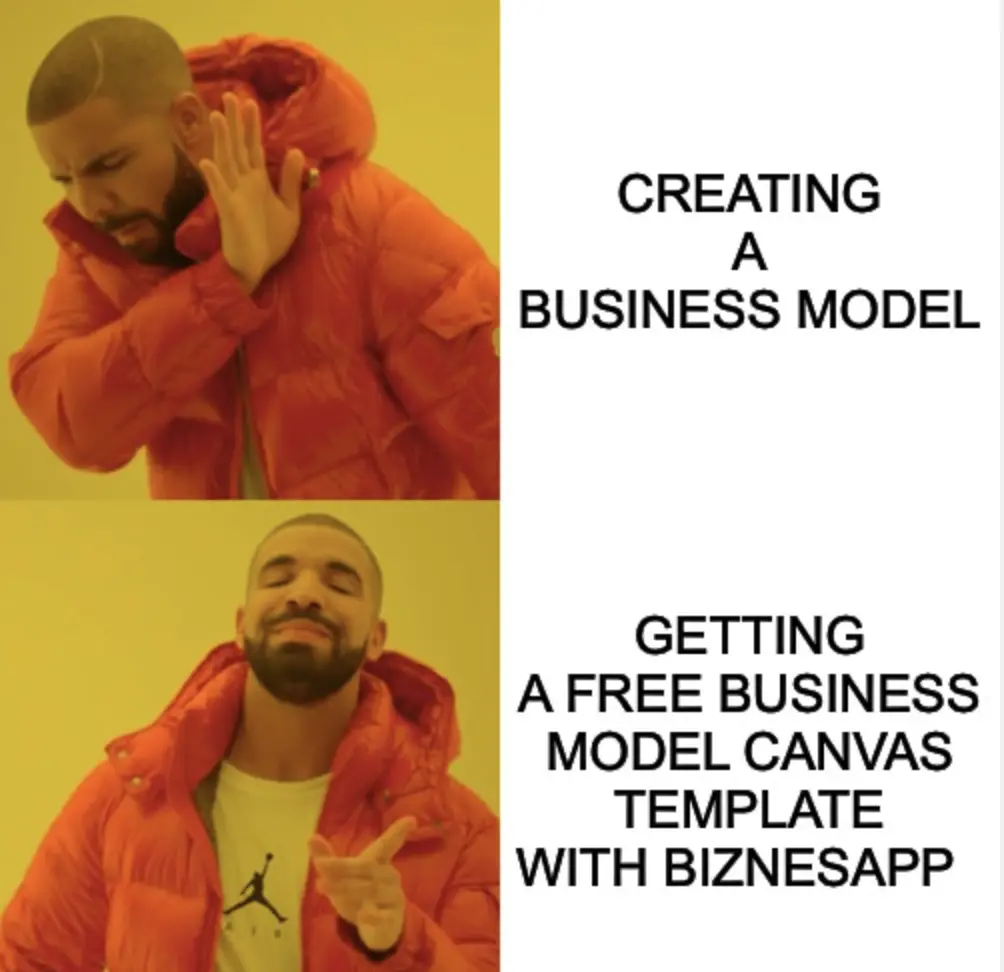
Examples of a business model canvas
Many corporate businesses have used the canvas approach for their business model. Below are some examples of some big-name companies and their business models:
1Airbnb business model canvas
Airbnb is a travel company that provides services for homestay accommodation for people travelling abroad. In their business model canvas, they explicitly outline two value propositions for each customer segment: hosts, the people who have spaces available to rent, and guests, the people who are looking for a place to stay.
- For hosts: their proposition for hosts is to be able to make money through the platform, with control over booking and insurance against damage and accidents
- For guests: their proposition is the ability to save money on rent and be able to choose a place tailored to their preferences with the help of one single device
The business model canvas states that their main channels are their website and app, social media pages, word of mouth, digital marketing and affiliate models. Airbnb makes revenue through hosts' and travellers' fees while establishing a relationship with customers through their 24/7 customer service support, user-friendly platform, and trust in marketplace transactions. They also ensure that customers' data and private information is protected securely.
Airbnb has partnered with investors, insurance companies and professional photographers alongside property hosts. Their competitors include Booking.com, HomeToGo, Tripadvisor and Expedia.
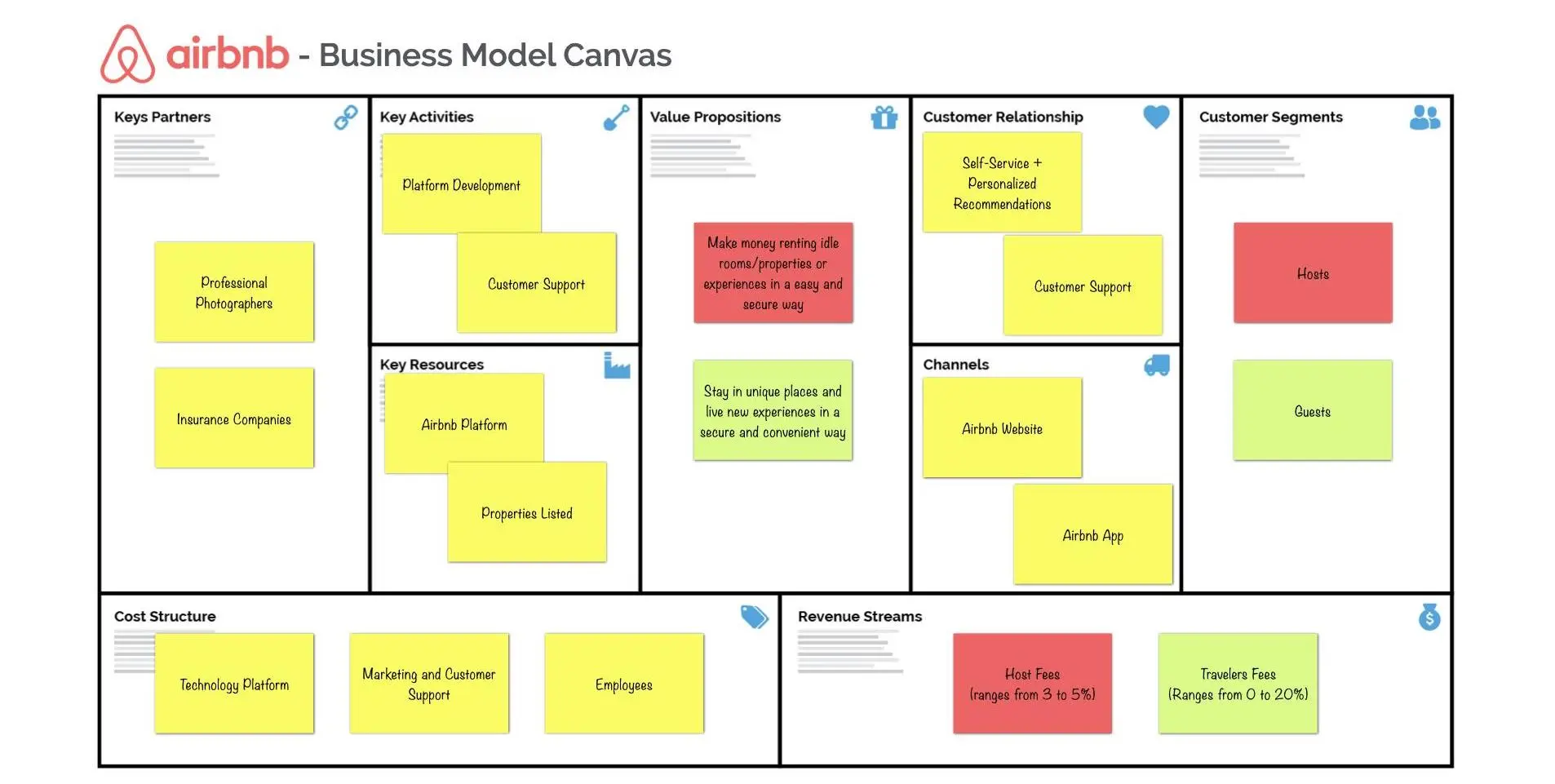
2Alibaba business model canvas
Alibaba is one of China's largest e-commerce companies. In their business model canvas, they outlined their value propositions as the following:
- Merchants: to help advertise a company to the global market
- Shoppers: encouraging Chinese citizens to order "an extensive amount of products" without having to leave their homes
- Stores: partnering with Alibaba to sell basic home items
Alibaba states that their main distribution channel is through their website and app (for iOS and Android devices), while they establish their relationship with customers through social media, phone, email and Q&As (question and answer). The company's main revenue streams are fees, membership programmes, advertisements, commissions and sales. Alibaba has also partnered with small businesses, medium-large manufacturers, banks and software companies. Their main competitors are Amazon, eBay, Walmart and Tencent.
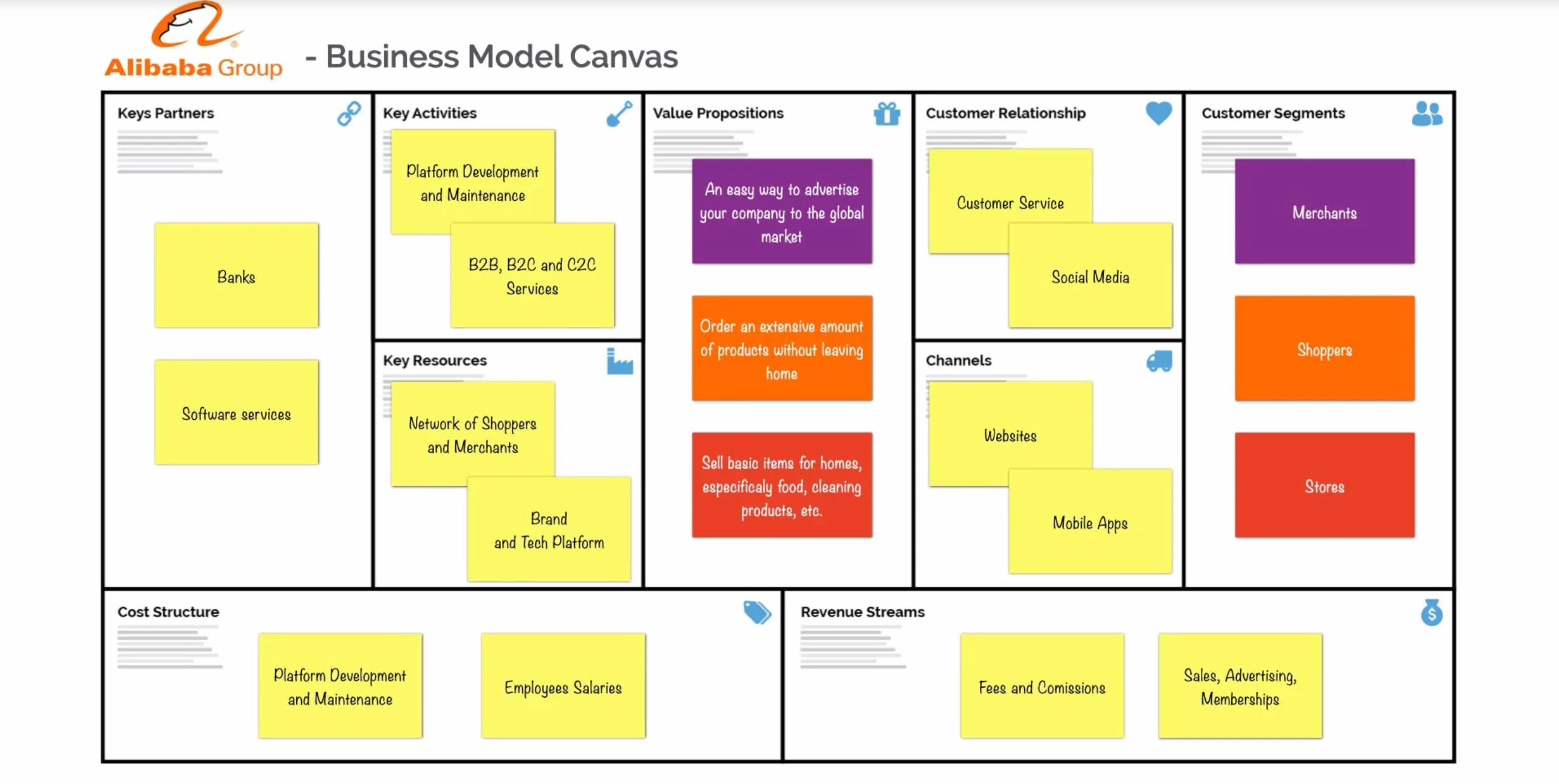
3eBay business model canvas
eBay is one of many e-commerce/marketplace companies available online. In their business model canvas, they highlighted their value propositions as being tailored towards three groups of people:
- For buyers: the ability to shop for a wide variety of goods from sellers all over the world
- For sellers: the ability to sell products online and reach a large audience of potential customers
- For advertisers: the ability to offer marketing services to help advertisers increase the visibility of their adverts through eBay
eBay's main channels are its website and app, as well as online and offline advertising, affiliate marketing programmes, social media, search engine results and email marketing. According to their business model canvas, they have built relationships with customers through customer support, user reviews and ratings, subscription services and social media.
eBay makes money through advertising, subsidiaries, listing fees and the eBay Plus subscription service. In addition, they partner with investors, vendors, shipping and logistic companies, subsidiaries, such as StubHub, and payment processors, while often collaborating with other companies in the e-commerce industry. The main competitors of eBay include Amazon, Alibaba, Walmart and Etsy.
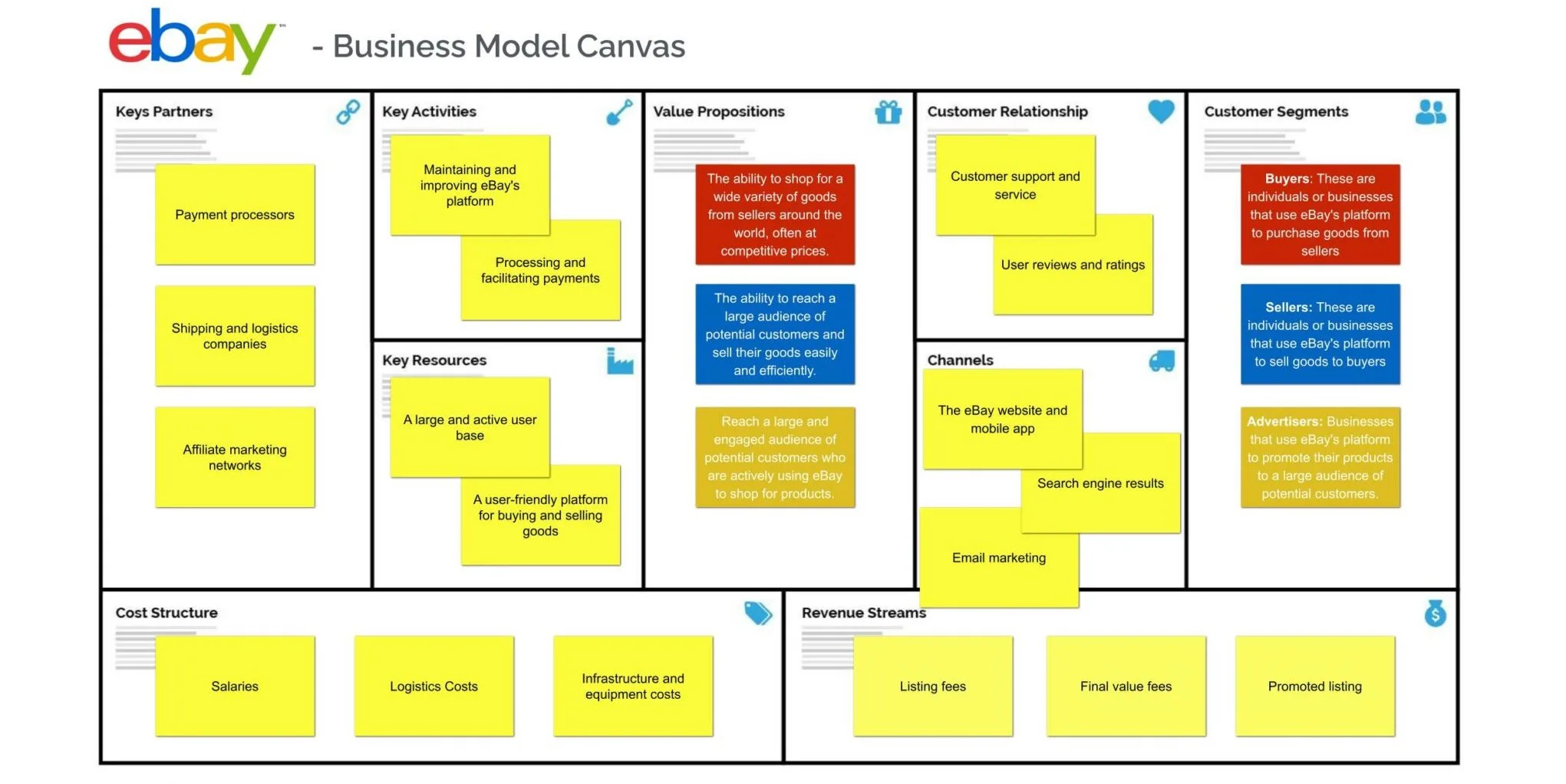
4eBay business model canvas
Deliveroo is one of the UK's leading food delivery companies. With their business model canvas, they outlined their value proposition as the following:
- To bring the world's local restaurants into everyone's home or office - fast
- For customers: a digital and effective way to order from their favourite restaurants (all deliveries under 32 minutes!)
- For restaurants: provides a delivery service for restaurants so that they don't need to invest in their fleet of vehicles or online ordering system
- For riders: a chance to earn extra income and exercise at the same time
The main channels of Deliveroo are their mobile app, although they have expanded their operations to a website as well. They also utilise a blog, social media and a restaurant business development team. As a result, Deliveroo has established great relationships with customers who desire a takeaway from their favourite places to eat, as well as corporate accounts, riders and the owners of restaurants themselves.
Deliveroo mainly makes revenue through a flat fee of £2.50 per delivery, their Deliveroo Plus subscription service and a commission that it charges restaurants for each order. Their main partners are their riders, restaurants, and insurances and technology providers. Deliveroo's competitors include Uber Eats, Just Eat, Zomato and DoorDash.
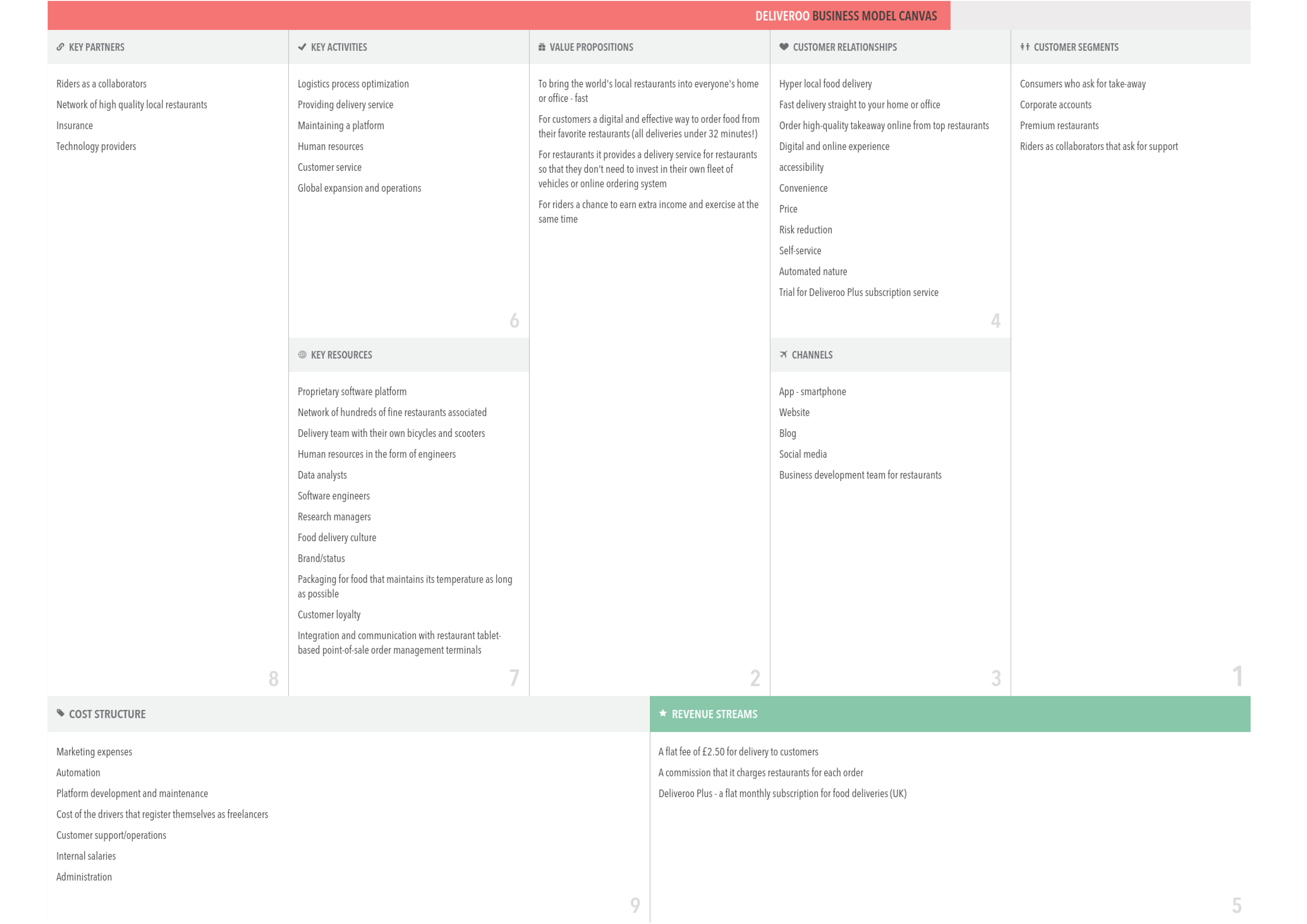
5Netflix business model canvas
Netflix is one of the biggest streaming platforms, hosting a vast library of films and television shows. It was originally founded as a DVD rental service in 1998 before evolving into a streaming service in 2007. With their business model canvas, Netflix has highlighted their value propositions as the following:
- Access to a huge catalogue of products, with content for all tastes
- On-demand streaming with 24/7 access
- Possibility of binge-watching
- Original and high-definition content
- Offering personalised lists and recommendations based on the content watched
- User accounts, which allow each person in the family to have a personalised profile
- All of this can be accessed through any device connected to the internet
As you can probably tell by their value proposition, Netlifx's main channels are their website and app. The company states they have formed a consumer relationship through the platform itself, with its user-friendly features and algorithm suggesting content based on what someone has viewed. Netflix also offers support through their customer services (email, live chat, phone) and promotes its content to customers through social media.
Netflix has partnered with consumer electronic producers such as Sony Playstation and Microsoft Xbox while they make revenue through subscriptions. The company's main competitors include other streaming giants such as Disney Plus, Amazon Prime Video, Hulu and HBO Max.
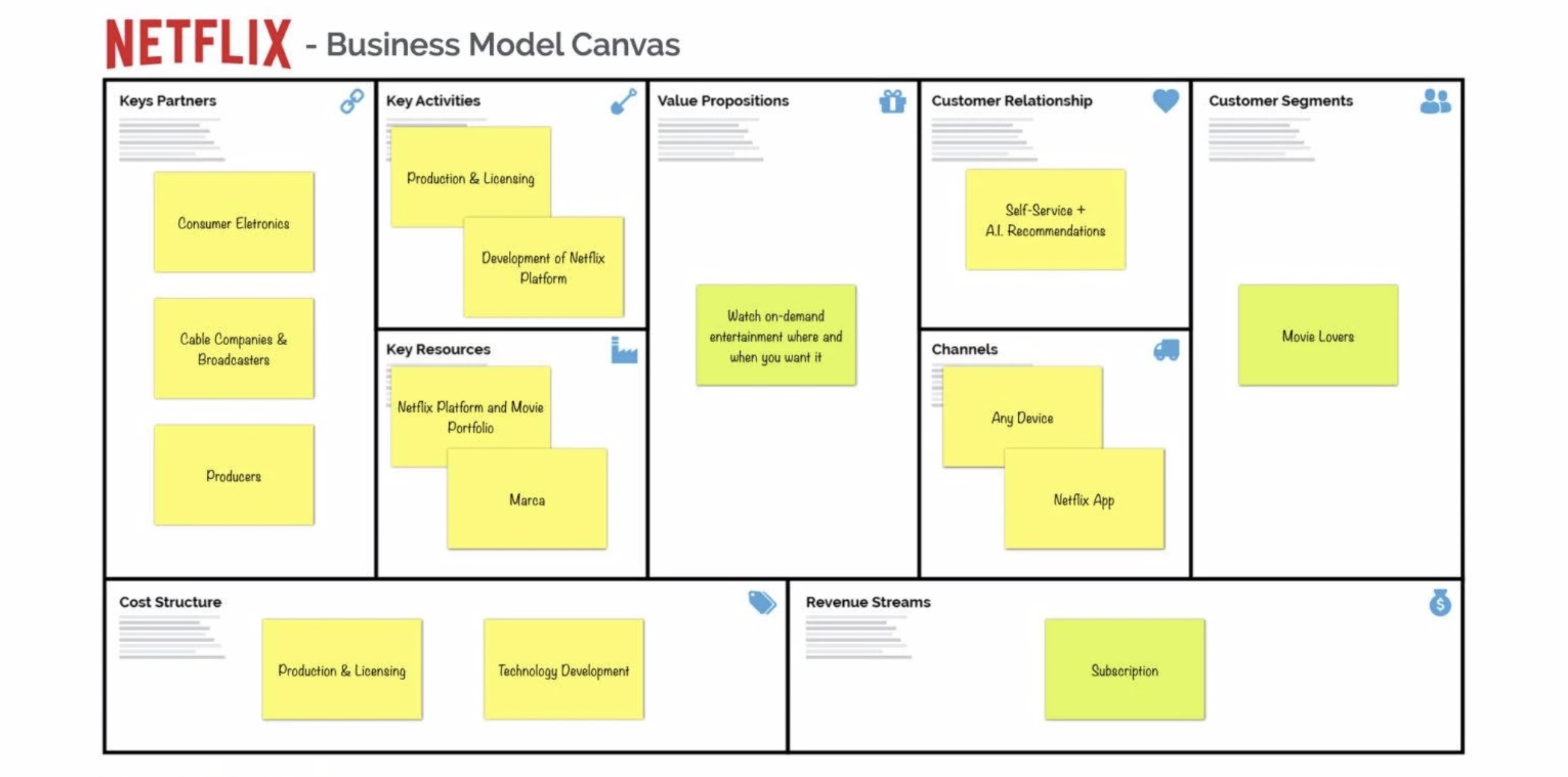
6Revolut business model canvas
Revolut is one of the largest online digital banking services. With their business model canvas, they outlined their value proposition as the following:
- To build a fair and frictionless platform to use and manage money around the world
- To remove hidden fees and offer interbank currency rates
- A digital baking alternative that includes a prepaid debit card
Revolut's main channels are their website, featuring blogs, a community centre and a help centre. They also utilise a smartphone app, social media and a multi-currency card, accepted anywhere in the world. Revolut makes its revenue through consumer add-ons, business accounts, and a fee paid to MasterCard by merchants to process their payments.
Revolut has maintained customer relationships with startups, founders, early adopters, digital nomads and millennials. The main partners of Revolut include business angels, banks and financial technology incubator Level39, while their competitors are Starling, Wise, Oxygen and Relio.
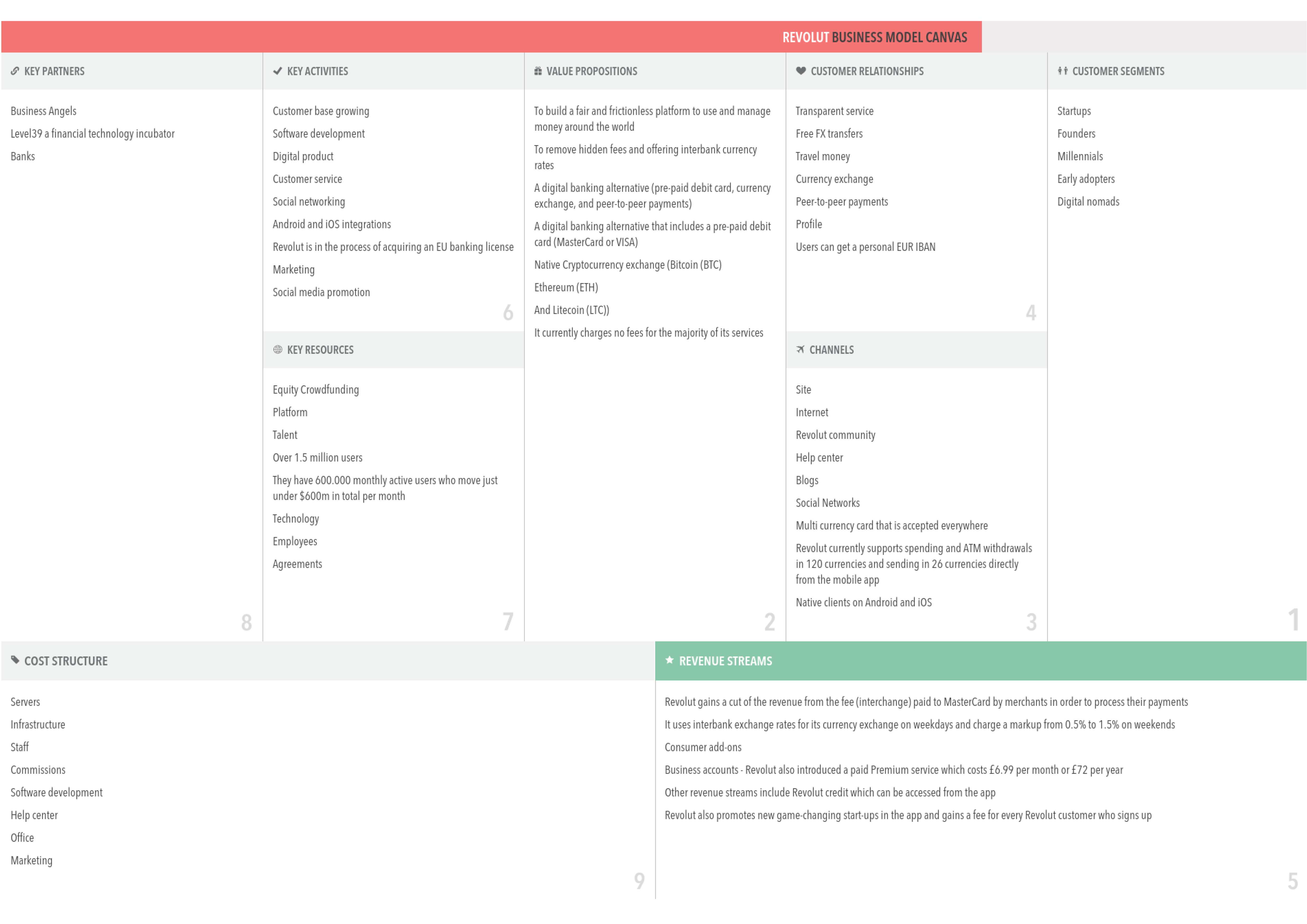
7Samsung business model canvas
Samsung is a South Korean manufacturing company renowned for its electronic devices. In their business model canvas, they outlined their value proposition as: "to devote their talent and technology to creating superior products and services that contribute to a better global society".
The main channels of Samsung include their products, such as Samsung Galaxy and Samsung TV, as well as distributors, events and presentations, media coverage and stores. In addition, Samsung also promotes itself through its company website and social media pages.
The main source of revenue for Samsung is from the sale of its electronic products, as well as licensing, service fees, manufacturing fees and multi-industry products and services. They have maintained good consumer relationships through the multi-industry companies they work with and the mass market. Samsung has partnered with Android (made by Google), investors, telecom companies, and acquisitions such as Rolle and Fokker, while they have formed joint ventures with Toshiba and Sony. Their main competitors include Apple, Nokia, HTC and Intel.
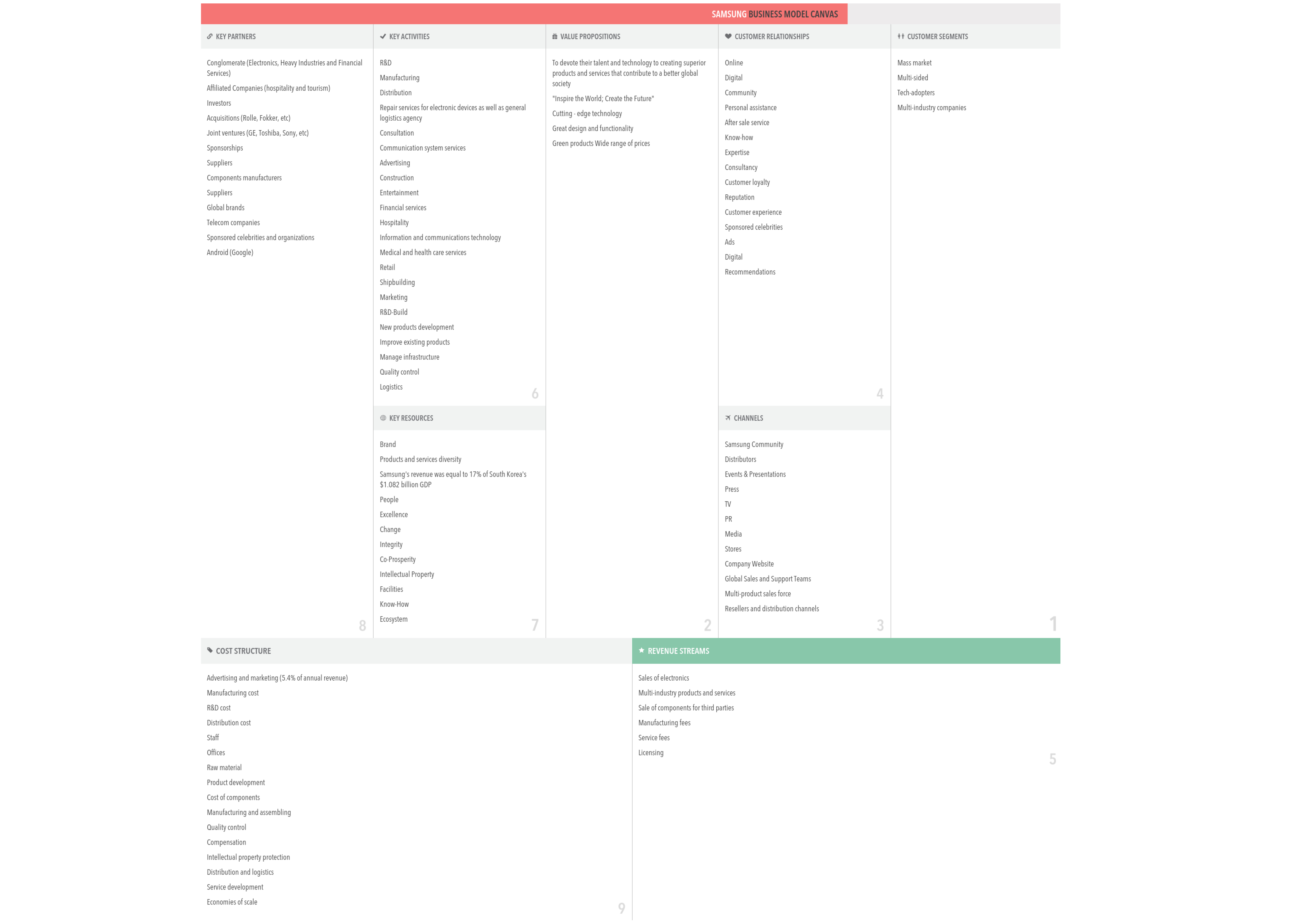
8Uber business model canvas
Uber is a popular car-sharing app. In their business model canvas, they highlighted that their main value proposition was providing a more convenient service than a taxi. Rather than a customer spending ages looking for a taxi, they let the car come to them. Cars are available 24/7 through the Uber app, with much lower fares than those charged by taxi drivers. Uber highlights that their biggest channel was through word of mouth, alongside social media. They make most of its revenue through a share percentage per ride and through its sister app Uber Eats.
Uber primarily focuses on their customers while maintaining relationships with their car drivers and regulators. The company sees their drivers as their key partner, who they believe helps them deliver its value proposition and generate revenue. The main competitors of Uber include Lyft, Curb, Grab and Cabify.
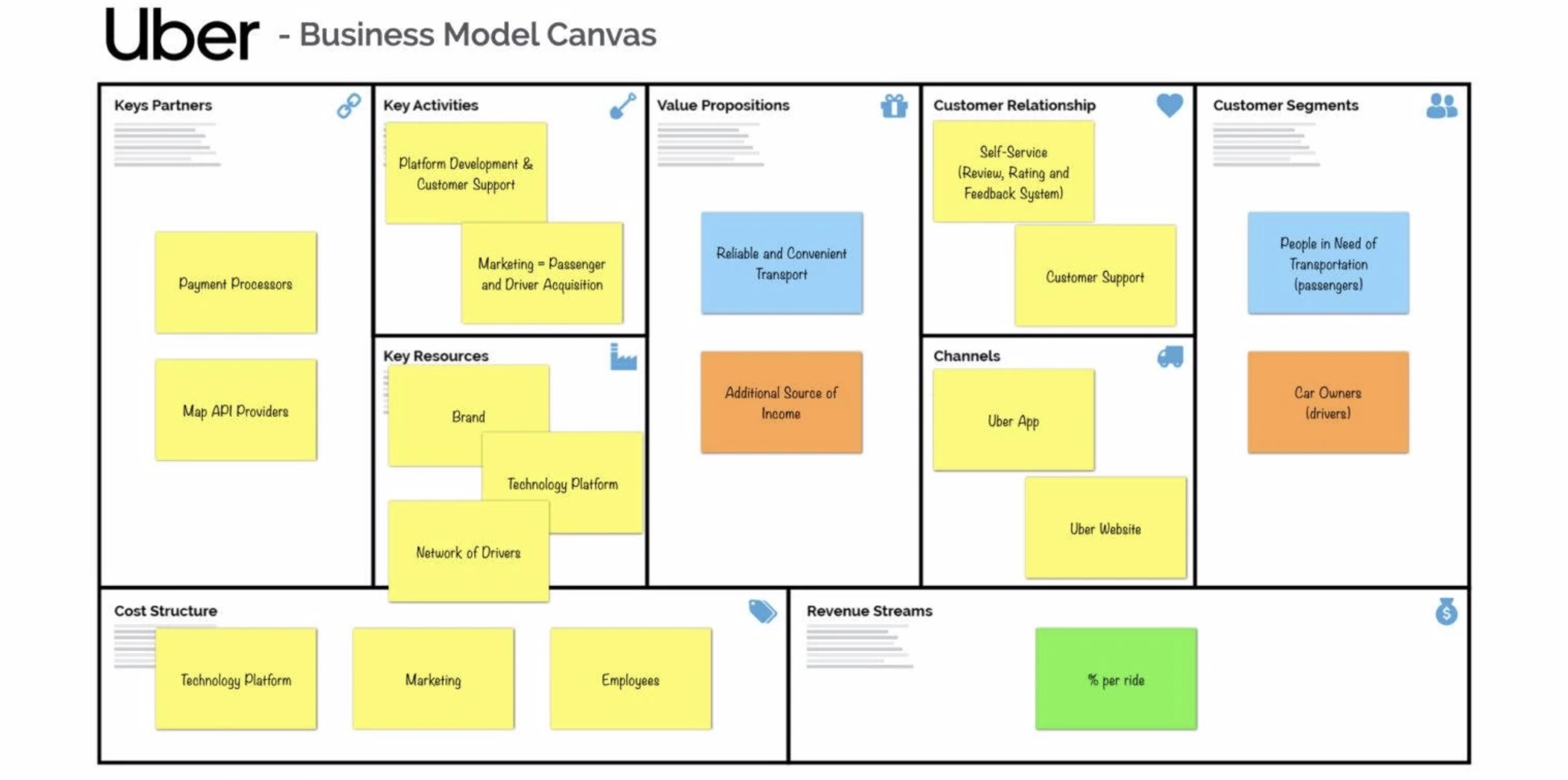
Conclusion
We hope this information has been useful in helping you find out more about a business model. Regardless of whether it is a written document or a canvas, you will need to emphasise the value proposition of your business and underline what your company is trying to achieve and the relationship between you and your customers. Remember that the nine points are key on how to build a business model that will become successful.
